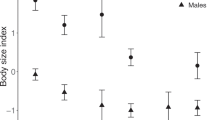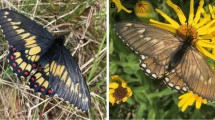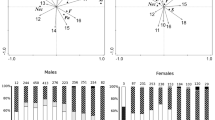Abstract
Our knowledge of the main determinants of invasion success is still incomplete. Among these factors, the effects of biological traits, including fecundity, longevity and dispersal in newly colonised regions, are pivotal. However, while numerous studies have considered ecological and evolutionary impacts of non-native species, their biology often remains understudied. Despite the continuous geographic expansion of Merizodus soledadinus (Coleoptera: Carabidae) at the Kerguelen Islands over recent decades, the main life-history parameters of this species are unknown. We determined adult longevity under controlled conditions, monitored seasonal activity through pitfall trappings, and analysed temporal variations of egg load and body reserves in field-collected individuals. The median adult life span (LT50) was 241 days, with maximum longevity of 710 days (N = 500). Females carried eggs throughout the year (8.94 ± 3.56 eggs per female), and it was not possible to pinpoint any clear egg-laying period. Year-round trappings demonstrated continuous activity of adults over seasons, with a peak during the austral summer that may arguably be associated with higher temperatures. Body stores (glycogen and proteins) did not vary significantly through the year, suggesting that adults feed continuously despite different prey availability between summer and winter, possibly via diet shifts. The amount of triglycerides increased at onset of summer, which may be associated with higher summer locomotor activity and/or more intense predation and reproduction.





Similar content being viewed by others
References
Arrese EL, Soulages JL (2010) Insect fat body: energy, metabolism, and regulation. Annu Rev Entomol 55:207–225. doi:10.1146/annurev-ento-112408-085356
Brandjes GJ, Block W, Ernsting G (1999) Spatial dynamics of two introduced species of carabid beetles on the sub-Antarctic island of South Georgia. Polar Biol 21:326–334. doi:10.1007/s003000050369
Callaway RM, Ridenour WM (2004) Novel weapons: invasive success and the evolution of increased competitive ability. Front Ecol Environ 2:436–443
Chevrier M, Vernon P, Frenot Y (1997) Potential effects of two alien insects on a subantarctic wingless fly in the Kerguelen Islands. In: Battaglia B, Valencia J, Walton DWH (eds) Antarctic communities: species, structure and survival. Cambridge University Press, Cambridge, pp 424–431
Chown SL, Gremmen NJM, Gaston KJ (1998) Ecological biogeography of Southern Ocean Islands: species–area relationships, human impacts, and conservation. Am Nat 152:562–575. doi:10.1086/286190
Colautti RI, Ricciardi A, Grigorovich IA, MacIsaac HJ (2004) Is invasion success explained by the enemy release hypothesis? Ecol Lett 7:721–733. doi:10.1111/j.1461-0248.2004.00616.x
Convey P, Key RS, Key RJD et al (2011) Recent range expansions in non-native predatory beetles on sub-Antarctic South Georgia. Polar Biol 34:597–602. doi:10.1007/s00300-010-0909-6
Core Team R (2016) R: A language and environment for statistical computing. R Foundation for Statistical Computing, Vienna
Davies L (1987) Long adult life, low reproduction and competition in two sub-Antarctic carabid beetles. Ecol Entomol 12:149–162. doi:10.1111/j.1365-2311.1987.tb00994.x
Ernsting G (1993) Observations on life cycle and feeding ecology of two recently introduced predatory beetle species at South Georgia, sub-Antarctic. Polar Biol 13:423–428. doi:10.1007/BF01681985
Falk-Petersen J, Bøhn T, Sandlund OT (2006) On the numerous concepts in invasion biology. Biol Invasions 8:1409–1424. doi:10.1007/s10530-005-0710-6
Foray V, Pelisson P-F, Bel-Venner M-C et al (2012) A handbook for uncovering the complete energetic budget in insects: the van Handel’s method (1985) revisited. Physiol Entomol 37:295–302. doi:10.1111/j.1365-3032.2012.00831.x
Frenot Y, Chown SL, Whinam J et al (2005) Biological invasions in the Antarctic: extent, impacts and implications. Biol Rev 80:45–72. doi:10.1017/S1464793104006542
Gurevitch J, Fox GA, Wardle GM et al (2011) Emergent insights from the synthesis of conceptual frameworks for biological invasions. Ecol Lett 14:407–418. doi:10.1111/j.1461-0248.2011.01594.x
Handley RJ, Steinger T, Treier UA, Müller-Schärer H (2008) Testing the evolution of increased competitive ability (EICA) hypothesis in a novel framework. Ecology 89:407–417. doi:10.1890/07-0160.1
Hayes KR, Barry SC (2008) Are there any consistent predictors of invasion success? Biol Invasions 10:483–506. doi:10.1007/s10530-007-9146-5
Hidalgo K, Laparie M, Bical R et al (2013) Metabolic fingerprinting of the responses to salinity in the invasive ground beetle Merizodus soledadinus at the Kerguelen Islands. J Insect Physiol 59:91–100. doi:10.1016/j.jinsphys.2012.10.017
Jeannel R (1940) Croisière du Bougainville aux iles australes françaises. III. Coléoptères, Mémoires du Musée National d’Histoire Naturelle. Paris, France
Kirk VM (1975) Biology of Pterostichus chalcites, a ground beetle of cropland. Ann Entomol Soc Am 68:855–858. doi:10.1093/aesa/68.5.855
Kolar CS, Lodge DM (2001) Progress in invasion biology: predicting invaders. Trends Ecol Evol 16:199–204. doi:10.1016/S0169-5347(01)02101-2
Lalouette L, Williams CM, Cottin M et al (2012) Thermal biology of the alien ground beetle Merizodus soledadinus introduced to the Kerguelen Islands. Polar Biol 35:509–517. doi:10.1007/s00300-011-1096-9
Laparie M, Renault D (2016) Physiological responses to temperature in Merizodus soledadinus(Col., Carabidae), a subpolar carabid beetle invading sub-Antarctic islands. Polar Biol 39:35–45. doi:10.1007/s00300-014-1600-0
Laparie M, Lebouvier M, Lalouette L, et al (2010) Variation of morphometric traits in populations of an invasive carabid predator (Merizodus soledadinus) within a sub-Antarctic Island. Biol Invasions 12:3405–3417. doi:10.1007/s10530-010-9739-2
Laparie M, Larvor V, Frenot Y, Renault D (2012) Starvation resistance and effects of diet on energy reserves in a predatory ground beetle (Merizodus soledadinus; Carabidae) invading the Kerguelen Islands. Comp Biochem Physiol A 161:122–129. doi:10.1016/j.cbpa.2011.09.011
Le Roux V, Chapuis J-L, Frenot Y, Vernon P (2002) Diet of the house mouse (Mus musculus) on Guillou Island, Kerguelen archipelago, Subantarctic. Polar Biol 25:49–57. doi:10.1007/s003000100310
Lê S, Josse J, Husson F (2008) FactoMineR: an R package for multivariate analysis. J Stat Softw 25:1–18. doi:10.18637/jss.v025.i01
Lebouvier M, Laparie M, Hullé M et al (2011) The significance of the sub-Antarctic Kerguelen Islands for the assessment of the vulnerability of native communities to climate change, alien insect invasions and plant viruses. Biol Invasions 13:1195–1208. doi:10.1007/s10530-011-9946-5
Löser S (1970) Brutfürsorge und Brutpflege bei Laufkäfern der Gattung Abax. Verhandlungen Dtsch Zool Ges Würzbg 1969:322–326
Lövei GL, McCambridge M (2002) Adult mortality and minimum lifespan of the ground beetle Harpalus affinis (Coleoptera: Carabidae) in New Zealand. N Z J Zool 29:1–4. doi:10.1080/03014223.2002.9518283
Luff ML (1973) The annual activity pattern and life cycle of Pterostichus madidus (F.) (Col. Carabidae). Insect Syst Evol 4:259–273. doi:10.1163/187631273X00228
Ottesen P (1990) Diel activity patterns of Carabidae, Staphylinidae and Perimylopidae (Coleoptera) at South Georgia, sub-Antarctic. Polar Biol 10:515–519. doi:10.1007/BF00233700
Ouisse T, Bonte D, Lebouvier M et al (2016) The importance of relative humidity and trophic resources in governing ecological niche of the invasive carabid beetle Merizodus soledadinus in the Kerguelen archipelago. J Insect Physiol 93–94:42–49. doi:10.1016/j.jinsphys.2016.08.006
Pimentel D, Zuniga R, Morrison D (2005) Update on the environmental and economic costs associated with alien-invasive species in the United States. Ecol Econ 52:273–288. doi:10.1016/j.ecolecon.2004.10.002
Pyšek P, Richardson DM (2008) Traits associated with invasiveness in alien plants: where do we stand? In: Nentwig DW (ed) Biological invasions. Springer, Berlin, pp 97–125
Renault D (2011) Sea water transport and submersion tolerance as dispersal strategies for the invasive ground beetle Merizodus soledadinus (Carabidae). Polar Biol 34:1591–1595. doi:10.1007/s00300-011-1020-3
Renault D, Chevrier M, Laparie M et al (2015) Characterization of the habitats colonised by the alien ground beetle Merizodus soledadinus at the Kerguelen islands. Rev Ecol 70:28–32
Rosenheim JA, Heimpel GE, Mangel M (2000) Egg maturation, egg resorption and the costliness of transient egg limitation in insects. Proc R Soc Lond B Biol Sci 267:1565–1573. doi:10.1098/rspb.2000.1179
Therneau T (2013) A package for survival analysis in S. R package version 2.37-4. http://CRAN.R-project.org/package=survival
Thiele HU (1977) Carabid beetles in their environments: a study on habitat selection by adaptations in physiology and behaviour. Springer, Stuttgart
Todd CM (1996) Body size, prey size and herbivory in Coleoptera from the sub-Antarctic island of South Georgia. Pedobiologia 40:557–569
Todd CM (1997) Respiratory metabolism in two species of carabid beetle from the sub-Antarctic island of South Georgia. Polar Biol 18:166–171. doi:10.1007/s003000050173
van Kleunen M, Dawson W, Schlaepfer D et al (2010) Are invaders different? A conceptual framework of comparative approaches for assessing determinants of invasiveness. Ecol Lett 13:947–958. doi:10.1111/j.1461-0248.2010.01503.x
Vilà M, Basnou C, Pyšek P et al (2010) How well do we understand the impacts of alien species on ecosystem services? A pan-European, cross-taxa assessment. Front Ecol Environ 8:135–144. doi:10.1890/080083
Williamson M (2006) Explaining and predicting the success of invading species at different stages of invasion. Biol Invasions 8:1561–1568. doi:10.1007/s10530-005-5849-7
Williamson M, Fitter A (1996) The varying success of invaders. Ecology 77:1661–1666. doi:10.2307/2265769
Wood SN (2004) Stable and efficient multiple smoothing parameter estimation for generalized additive models. J Am Stat Assoc 99:673–686. doi:10.1198/016214504000000980
Acknowledgements
The French Polar Institute Paul-Emile Victor that supports our program IPEV 136 ‘Subanteco’ is warmly thanked. This study was granted by InEE-CNRS (Enviromics call, ‘ALIENS’; Zone Atelier Antarctique et Subantarctique). Part of the experiments were conducted at the ABGC platform (UMR CNRS EcoBio). Our samplers and breeders of Merizodus soledadinus at Port-aux-Français from 2013 to 2015—Elsa Day, Lauriane Laville, Solène Lebreton and Camille Thomas—are warmly thanked.
Author information
Authors and Affiliations
Corresponding author
Ethics declarations
Conflict of interest
The authors declare that they have no conflict of interest.
Ethical consent
National and international laws concerning animal experimentation conditions were respected in this study.
Electronic supplementary material
Below is the link to the electronic supplementary material.
300_2017_2134_MOESM1_ESM.pdf
Tab.ESM_1 Summary of the hand-collected samples used to investigate the reproductive status of females during the year. The number of individuals captured is pooled for each month if the number of samples per month exceeds one. The sex ratio of each month is calculated as the proportion of females per sample (PDF 184 kb)
300_2017_2134_MOESM3_ESM.pdf
Fig.ESM_2 Mean egg load in dissected female Merizodus soledadinus sampled monthly between December 2010 and March 2012 (20 individuals per sampling date, when possible) (PDF 222 kb)
Rights and permissions
About this article
Cite this article
Ouisse, T., Laparie, M., Lebouvier, M. et al. New insights into the ecology of Merizodus soledadinus, a predatory carabid beetle invading the sub-Antarctic Kerguelen Islands. Polar Biol 40, 2201–2209 (2017). https://doi.org/10.1007/s00300-017-2134-z
Received:
Revised:
Accepted:
Published:
Issue Date:
DOI: https://doi.org/10.1007/s00300-017-2134-z




